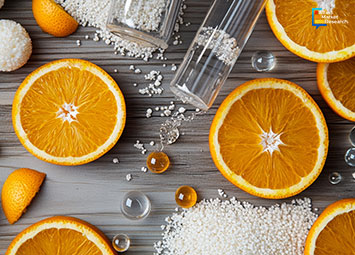Citrus Aurantium Extract: Understanding Its Role in Industrial Applications

17 Jul
2025
Highlights:
- Introduction
- Versatile Applications
- Growing Industry Demand
Citrus Aurantium, more commonly known as bitter orange, has steadily found its way into the ingredient lists of numerous industrial applications. Extracted from the peels, leaves, or flowers of the bitter orange tree, this component is no longer just part of traditional medicine or ancient diets. It now plays a growing role in sectors like pharmaceuticals, nutraceuticals, cosmetics, and food processing. Businesses dealing with functional ingredients and botanical extracts are increasingly examining the role citrus aurantium extract plays in product formulations, supply chains, and compliance challenges.
One of the key reasons behind the popularity of this extract is its diverse chemical composition. It contains active compounds like synephrine, flavonoids, and limonene. These elements contribute to a variety of functions, making the extract a sought-after input for businesses formulating dietary supplements, weight management products, and energy-enhancing blends. In the pharmaceutical and nutraceutical sectors, synephrine has gained traction as an alternative to ephedrine, though companies are always cautious due to regulatory reviews around its potential cardiovascular effects.
Product developers in the food and beverage segment have also found use of citrus aurantium extract in flavoring and preservation. Its bitter profile works well in beverages like tonics and health drinks, offering a natural substitute to synthetic additives. Moreover, certain food manufacturers explore its antimicrobial properties to support shelf-life extension and product safety. In skincare and cosmetics, the extract’s astringent and antioxidant qualities support its inclusion in creams, cleansers, and toners. These varied applications have made it a multi-functional ingredient in commercial formulations.
Despite its wide use, businesses working with the extract are constantly adjusting to the evolving safety landscape. Several regulatory bodies, including the U.S. Food and Drug Administration (FDA) and the European Food Safety Authority (EFSA), have issued warnings or guidelines around synephrine levels in supplements. This has encouraged companies to revisit formulation levels and labeling transparency to stay within permissible use limits. In some regions, specific labeling is required to disclose the presence of synephrine, especially when the extract is used in supplements aimed at weight loss or energy enhancement.
Product developers are responding by adjusting concentration levels and conducting in-house safety testing. While citrus aurantium extract has not been banned in most countries, companies are increasingly treating it as a high-attention ingredient. This has also led to changes in procurement strategies, with buyers preferring extract varieties that are standardized to lower synephrine content or include documentation on clinical testing. There’s also growing interest in using whole-plant extracts with balanced phytochemical profiles rather than highly concentrated isolates. According to Allied Market Research, the citrus aurantium extract industry accounted for $3.9 billion in 2024 and is expected to reach $5.7 billion by 2034, citing a CAGR of 3.8% during 2025-2034.
Recent updates from ingredient trade publications and supply-chain sources suggest that the availability of Citrus Aurantium extract is currently being influenced by shifts in agricultural outputs. In 2024, several citrus-producing regions, including parts of Brazil and southern China, reported lower harvests due to unexpected weather patterns. This affected the availability of bitter orange fruit, prompting some processors to source from alternative regions or shift to seasonal procurement models.
The impact of this shift has been evident in the ingredient procurement segment, where buyers are being advised to secure longer-term contracts or diversify supplier bases. Several ingredient suppliers also reported an increase in inquiries for organic or sustainably sourced extract varieties. This reflects a broader business trend of sourcing botanicals with verified certifications, not only to meet end-consumer expectations but also to ease cross-border compliance issues.
Meanwhile, a May 2025 report from a European food safety conference emphasized the increased scrutiny on certain herbal extracts used in dietary supplements, including citrus aurantium. The discussion focused on the importance of transparent documentation, particularly for imports. Businesses exporting extracts are being advised to include full chemical breakdowns and safety profiles to facilitate smoother customs clearance and meet EU standards.
For business stakeholders, the focus is now shifting toward sourcing transparency and documentation. Extract suppliers and distributors are under growing pressure to demonstrate traceability, from farm to finished batch. This is especially important for buyers in the European and North American regions, where ingredient transparency is closely associated with brand reputation and regulatory risk.
Innovation in extraction techniques is another area gaining importance. Companies are exploring low-temperature, solvent-free extraction methods to retain more of the plant’s native compounds. These methods also cater to brands looking for “clean label” claims. Furthermore, some suppliers are integrating the extract with other botanicals like green tea or guarana to create customized blends for contract manufacturers. These blended ingredients are being positioned as ready-to-use solutions for supplement brands, energy formulations, and cosmetic developers.
There’s also a noted shift toward examining the extract’s role in gut health. Some R&D teams in the dietary supplement sector are testing its prebiotic potential, though research is at early-stage. For now, most functional benefits are focused on energy, digestion, and skin health.
Citrus aurantium extract evolves as a multifunctional ingredient with wide applications across industrial sectors. Its adoption requires careful handling, given the active compounds it contains and the regulatory attention it attracts. From problems caused by climate events to the need for better traceability and safety information, it’s getting harder for businesses to deal with ingredients. Going forward, businesses need smart and safe ways to use such powerful natural ingredients.
Reach out to our team of experts to explore the latest developments in the citrus aurantium extract industry.
✍ **𝑨𝒓𝒕𝒊𝒄𝒍𝒆 𝒘𝒓𝒊𝒕𝒆𝒓: Koyel Ghosh

Koyel Ghosh
Author’s Bio- Koyel Ghosh is a blogger with a strong passion and enjoys writing in miscellaneous domains, as she believes it lets her explore a wide variety of niches. She has an innate interest in creativity and enjoys experimenting with different writing styles. A writer who never stops imagining, she has been serving the corporate industry for the last five years.
Avenue: Entire Library membership of Allied Market Research Reports at your disposal
- Avenue is an innovative subscription-based online report database.
- Avail an online access to the entire library of syndicated reports on more than 2,000 niche industries and company profiles on more than 12,000 firms across 11 domains.
- A cost-effective model tailored for entrepreneurs, investors, and students & researchers at universities.
- Request customizations, suggest new reports, and avail analyst support as per your requirements.
- Get an access to the library of reports at any time from any device and anywhere.
Related Post
-
How are Submarine Cables Transforming Global Connectivity with Enhanced User Experience?
-
Endoscopy Procedures: Transformations in Techniques and Applications
-
AI-Powered Video Analytics: How the Product Actually Works for enterprises
-
Painting Robots: Transforming Precision Coating and Creative Applications
-
Innovations in Pharmacovigilance Systems Advancing Patient Safety
-
Understanding Edge Security: Keeping Data Safe Near the Source
-
Exploring the Use and Advancements of 3D Laser Scanners in Professional Applications
-
Reinforcing Industrial Controls with Smarter Tools and Training








